Betelvine Insect Pests
Betelvine Insect Pests
Scale insect
Biology:
- Scales have unusual life cycles.
- The eggs are laid underneath the waxy covering and hatch over a period of one to three weeks.
- The newly hatched scales (called crawlers) move about over the plant until they locate succulent new growth.
- They insert their piercing-sucking mouthparts into the plant and begin feeding. Female scales lose their legs and antennae during the first molt.
- They molt a second time before reaching maturity and do not pupate.
- The cast skins (exuviae) are incorporated in the scale cover.
- Male scales go through two additional molts and pupate underneath the wax. Adult males are tiny two-winged, gnat-like insects without mouthparts.
- Lepidosaphes is small, dark, boat shaped.
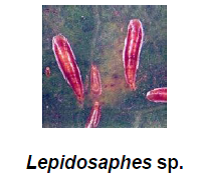
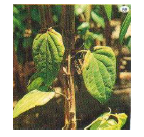
Damage symptoms:
Both nymph and adults infest the leaves, petioles and main veins. The scale infested leaves loose their colour, exhibit warty appearance, crinkle and dry up ultimately. The affected vines present a sticky appearance and wilt in due course.
Natural enemies of scales:
- Parasitoids: Encarsia citrine, Aphytis sp.
- Predators: Bdella sp. Aleurodothrips jasciatus, Karnyothrips melaleucus, Chilocorus circumdatus, C. nigrita, Pharoscymnus horn; Pseudoscymnus, Lacewings, mirids, Pytoseiids beetles
Red spider mite
Biology:
- Egg: Eggs are reddish, spherical, provided with a small filament. Incubation period is 4-6 days, before hatching becomes light orange colour.
- Nymph: Upon hatching, it will pass through a larval stage and two nymphal stages before becoming adult. Developmental stages include six legged larva, protonymph and deutonymph.
- Adult: Adult female is elliptical in shape, bright crimson anteriorly and dark pruplish brown posteriorly. Mites spin a web of silken threads on the leaf. Each developmental stage is followed by a quiescent stage and life cycle completed in 10-14 days.
Life cycle:
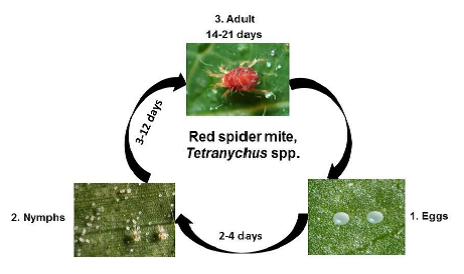
Damage symptoms:
- Spider mites usually extract the cell contents from the leaves using their long, needlelike mouthparts. This results in reduced chlorophyll content in the leaves, leading to the formation of white or yellow speckles on the leaves.
- In severe infestations, leaves will completely desiccate and drop off. The mites also produce webbing on the leaf surfaces in severe conditions. Under high population densities, the mites move to using strands of silk to form a ball-like mass, which will be blown by winds to new leaves or plants, in a process known as “ballooning.”
Natural enemies of mites:
Predators: Anthocorid bugs (Orius spp.), mirid bugs, syrphid/hover flies, green lacewings (Mallada basalis and Chrysoperla zastrowi sillemi), predatory mites (Amblyseius alstoniae, A. womersleyi, A. fallacies and Phytoseiulus persimilis), predatory coccinellids (Stethorus punctillum), staphylinid beetle (Oligota spp.), predatory cecidomyiid fly (Anthrocnodax occidentalis), predatory gall midge (Feltiella minuta), spiders etc.
Yellow mite
Biology:
- Egg: Eggs are oval shaped large, obovate, flattened at the bottom and white in colour. Eggs are glued firmly on the leaf surface and hatches after 27-32 hours
- Nymph: Nymphs white in colour.
- Adult: Adults large, oval and broad and yellowish in colour. Females are yellowish and bigger than the males and they carrying the “female nymphs” on their back.
Life cycle:
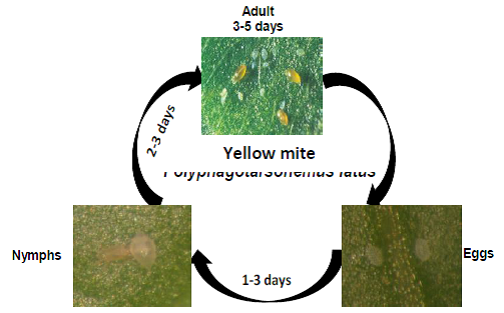
Damage symptoms:
- Mite is seen on young leaves especially the top two to three leaves and the bud.
- Affected leaves become rough and brittle and with corky lines.
- Downward curling.
- Internodes get shortened
Thrips
Biology:
- Egg: White to yellow, kidney-bean shaped, microscopic in size. Develop within leaf tissue with one end near the leaf surface. Egg stage is 5-10 days.
- Larva: Instars I and II are active, feeding stages. White to pale yellow, elongate and slender body. Resemble adult, but without wings. Antennae are short and eyes are dark in color. Feed on new leaves in the center of the onion neck. Crawl quickly when disturbed. Larval stage is 10-14 days.
- Pre-pupa and pupa: Instars III and IV are inactive, non-feeding stages called pre-pupa and pupa. Pale yellow to brown; body more stout than younger instars. Antennae are bent to head; wing buds are visible. Found in the soil, at the base of the onion plant neck, or underneath bulb scales. Lasts 5-10 days.
- Adult: About 1.5 mm long; elongate, yellow and brown body with two pairs of fringed (hairy) wings. Mouthparts are beak-like and antennae are 7-segmented. Spend the winter in protected sites under plants and debris in onion, alfalfa and small grain fields, and other plant habitats. In the spring when temperatures warm, adults fly to new onion fields. Parthenogenic (asexually reproducing) females; males are extremely rare. Feed on young leaves in center of onion neck and insert eggs individually into leaves. Fly readily when disturbed. Adult life span is about 1 month; pre-oviposition period (time before egg-laying begins) is 1 week and females will lay eggs for about 3 weeks.
Life cycle
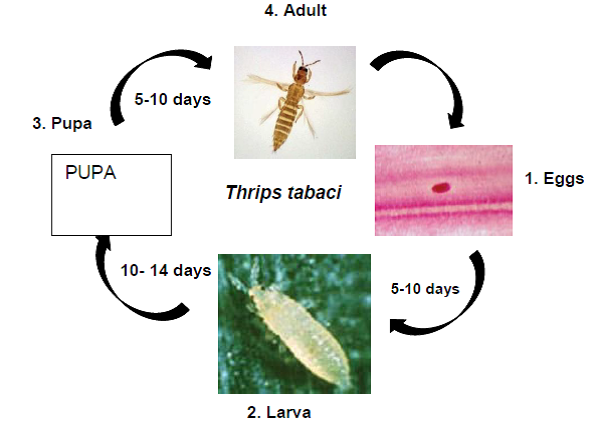
Damage symptoms:
Thrips prefer to feed on the newly emerged leaves. Under crowded conditions, they will move toward leaf tips to feed. Both adult and larval thrips feed within the mesophyll layer using a punch-and suck motion. The beak and mandible is thrust forward to puncture the leaf epidermis and sap released from injured plant cells is sucked up. Removal of chlorophyll causes the feeding area to appear white to silvery in color. Areas of leaf injury can occur as patches and streaks. When feeding injury is severe, leaves take on a silvery cast and can wither. Tiny black “tar” spots of thrips excrement are evident on leaves with heavy feeding injury.
Natural enemies of thrips:
- Parasitoids: Ceranisus menes (nymph).
- Predators: Syrphid flies, minute pirate bug/anthocorid bug (Blaptosthethus sp, Buchananiella whitei, Orius tantilus), praying mantis, predatory thrips (Aeolothrips fasciatum), damsel bug, lace wings, coccinellids (Menochilus sexmaculatus), spiders etc.
Shoot bug
Biology:
- The adult is reddish brown bug. It thrusts its eggs singly within the tender plant parts. Egg period 8 - 16 days. Fecundity 72 eggs/female. Nymphal period 12 - 18 days. The incidence of this pest is severe in June to October.
Damage symptoms:
- Both nymph and adults suck the sap from the tender leaves causing leaf blotches leading to ultimate drying.
Aphids
Biology:
- Egg: Eggs are very tiny, shiny-black, and are found in the crevices of bud, stems, and barks of the plant. Aphids usually do not lay eggs in warm parts of the world.
- Nymph: Nymphs (immature stages) are young aphids, they look like the wingless adults but are smaller. They become adults within 7 to 10 days.
- Adult: Adults are small, 1 to 4 mm long, soft-bodied insects with two long antennae that resemble horns. Most aphids have two short cornicles (horns) towards the rear of the body
Life cycle:
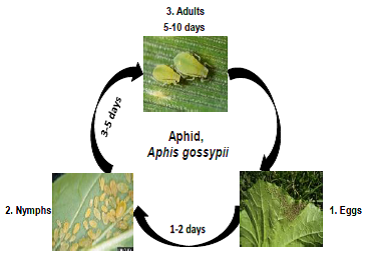
Damage symptoms:
- Infesting tender shoots and under surface of the leaves.
- Curling and crinkling of leaves
- Stunted growth
- Development of black sooty mould due to the excretion of honeydew
Natural enemies of aphids:
- Parasitoids: Aphelinus spp. Aphytis spp., Diaeretiella rapae
- Predators: Ladybird beetles viz., Coccinella septempunctata, Menochilus sexmaculatus, Hippodamia variegata and Menochilus vicina, Syrphid fly: Sphaerophoria spp., Eristallis spp., Metasyrphis spp., Xanthogramma spp. and Syrphus spp.Lacewing: Chrysoperla zastrowi sillemi, Aphid midge: Aphidoletes aphidimyza, Predatory bird: Motacilla cospica
- Entomopathogenic fungi : Cephalosporium spp., Entomophthora and Verticillium lecani
Mealybug
Biology:
- Egg: Eggs are deposited as white cottony masses called ovisacs. The glossy, light yellow eggs are oval and approximately 0.3 mm long. A female lay 300 to 600 eggs in a life period, which are deposited in groups of 5 to 20.
- Nymph: Nymphs emerge from the ovisacs and typically settle along midribs and veins on the underside of leaves and young twigs. Wax and honeydew secreted by crawlers are visible indicators of infestations. The nymphs are yellow, oval-shaped with red eyes, and covered with white waxy particles The female nymphs resemble the adult female in appearance, while male nymphs are more elongated. Female nymphs have four instars.
- Adult: Adult size ranges in length from 3 mm (females) to 4.5 mm (males). The females are wingless, white to light brown in color, with brown legs and antennae. The body of adult females is coated with white wax and bears a characteristic faint gray stripe along their dorsal side. Short waxy filaments can be seen around the margins of their oval body with a slightly longer pair of filaments present at the rear end of their body.
Life cycle:
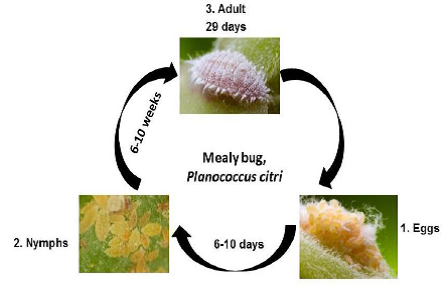
Damage symptoms:
- Young plants – susceptible for heavy infestation.
- Infest tender branches, nodes, leaves, spikes, berries and roots
- Both nymphs and adults suck the sap from the leaves.
- Severe infestation - Chlorotic leaves, aborted flower buds and small berries
- Honey dew excrete – development of sooty mould fungus (affects photosynthesis)
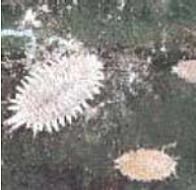
Natural enemies of mealybugs:
- Parasitoid: Leptomastix dactylopii etc.
- Predators: Ladybird beetle Cryptolaemus montrouzieri, spider, reduviid etc
Whitefly
Biology:
- Egg: The whitefly lays yellow eggs with a nearly smooth surface, distinguishing them from eggs of the cloudy winged whitefly, which are yellow when freshly laid, but soon turn black and have a surface that is netted with a system of ridges.
- Nymph: The nymph is a flat, elliptical, scale-like object, closely fastened to the underside of a leaf. It becomes fixed after the first molt. The nymphs, after the first instar, are flattened, oval, and are similar in appearance to the early instars of the unarmored scale insects. Like the scale insects, whiteflies lose their normal legs and antennae after the first molt (they are kept, but are abbreviated), but unlike the scale insects, the females gain them back in the adult stage. The nymphs of the whitefly lack a fringe of conspicuous, white, waxy plates or rods extending out from the margin of the body, which characterizes some species of whiteflies. Nymphs of both species are translucent, oval in outline, and very thin. Because the green color of the leaf shows through the body, nymphs are difficult to see. Pupae are similar but are thickened and are somewhat opaque, and eye spots of the developing adult may show through the pupal skin.
- Adult: The adult is a tiny, mealy-white insect with four mealy-white wings that expand less than 1/8 of an inch. The adults of both sexes have two pairs of wings covered with a white, powdery wax which gives the insects their common name. In the middle of each wing, cloudy winged whitefly adults have a darkened area which is lacking in the wings of the whitefly, and the wings fold to a flatter position than those of the whitefly.
Life cycle:
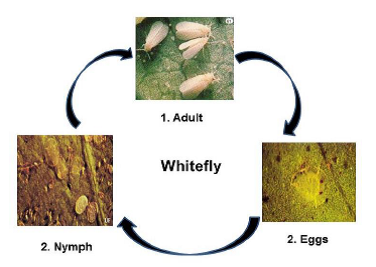
Damage symptoms:
Both nymph and adults suck the sap from the tender leaves causing yellowing, chlorotic spots and shooty mould development on leaves.
Natural enemies of whitefly:
- Parasitoids: Cryptognatha spp. (egg), Encarsia sp, Eretmocerus sp, Chrysocharis pentheus (nymphal)
- Predators: Mirid bug (Dicyphus hesperus), dragonfly, spider, Ladybird beetle, lacewings, mites, ants, and a species of thrips, Aleurodothrips fasciapennis
Root knot nematode
Biology:
- Most species of plant parasitic nematodes have a relatively simple life cycle consisting of the egg, four larval stages and the adult male and female.
- Development of the first stage larvae occurs within the egg where the first molt occurs. Second stage larvae hatch from eggs to find and infect plant roots or in some cases foliar tissues.
- Under suitable environmental conditions, the eggs hatch and new larvae emerge to complete the life cycle within 4 to 8 weeks depending on temperature.
- Nematode development is generally most rapid within an optimal soil temperature range of 70 to 80°F.
Life cycle
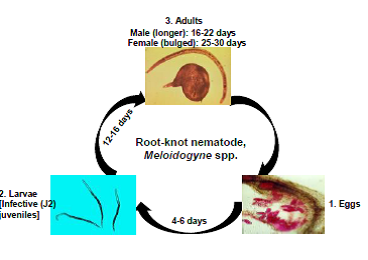
Damage symptoms:
- Infected plants in patches in the field
- Formation of galls on host root system is the primary symptom
- Roots branch profusely starting from the gall tissue causing a ‘beard root’ symptom
- Infected roots become knobby and knotty
- In severely infected plants the root system is reduced and the rootlets are almost completely absent. The roots are seriously hampered in their function of uptake and transport of water and nutrients
- Plants wilt during the hot part of day, especially under dry conditions and are often stunted
- Nematode infection predisposes plants to fungal and bacterial root pathogens
Survival and spread:
- Primary: Egg masses in infected plant debris and soil or collateral and other hosts like Solonaceous, Malvaceous and Leguminaceous plants act as sources of inoculums.
- Secondary: Autonomous second stage juveniles that may also be water dispersed.
Favourable conditions: Loamy light soils.
IPM for Betelvine
To know the IPM practices for Betelvine, click here.
Source: NIPHM; Directorate of Plant Protection, Quarantine & Storage
Last Modified : 3/30/2020
This topic covers the information related to Insec...
This topic covers information about Betelvine Nutr...
This topic covers information about Betelvine Desc...
This topic covers information about Betelvine Bene...
